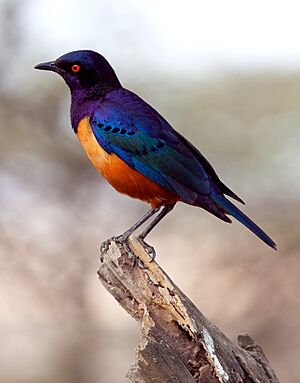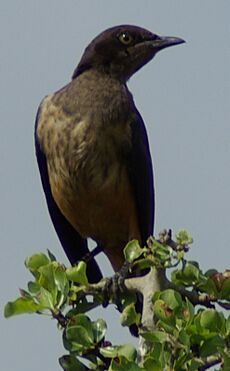Hildebrandt's starling facts for kids
Quick facts for kids Hildebrandt's starling |
|
|---|---|
 |
|
| Adult in Tanzania | |
| Conservation status | |
| Scientific classification |
The Hildebrandt's starling (Lamprotornis hildebrandti) is a beautiful bird. It belongs to the starling family, called Sturnidae. This starling is closely related to Shelley's starling, which travels a lot. Shelley's starling lives in places like Ethiopia, Somalia, and Kenya.
Hildebrandt's starling also shares a close family link with the chestnut-bellied starling from West Africa. This bird was named after Johann Maria Hildebrandt. He was a German collector who first found these birds for science.
Contents
Where Hildebrandt's Starling Lives
Hildebrandt's starling can be found in Kenya and Tanzania. It likes to live in open areas. These areas are usually between 500 and 2,200 meters (about 1,600 to 7,200 feet) above sea level.
Its home is often open woodlands and thorny bush country. Sometimes, people say this bird is uncommon. But its numbers can change from being quite common to a bit rare. The IUCN (a group that checks on animals) does not think this starling is in danger. It is listed as "least concern." This means its home is safe, and it lives in many protected areas.
What Hildebrandt's Starling Looks Like

The Hildebrandt's starling is about 18 centimeters (7 inches) long. It weighs between 50 and 69 grams (about 1.8 to 2.4 ounces). Adult birds have very bright, shiny feathers on their upper bodies. This shiny look is called iridescence. It comes from how light bounces off tiny parts of their feathers. It's not from colors in the feathers themselves!
The head of this starling is blue. Most of its upper body is also blue. Its wings are a bronze-green color with blue flight feathers. The throat and upper chest are a shiny purple. The tail is a shiny blue-green. The middle of its chest and upper belly are orange-buff. The lower belly is a reddish-brown color. Its eyes are orange-red, and its beak and legs are black.
Male and female adult starlings look exactly the same. People sometimes confuse them with the superb starling. Young starlings look very different. They have dark gray upper bodies and chestnut brown lower bodies.
This bird makes many different sounds. Its song is slow and low, like "ch-rak ch-rak chee-chee-wee chee-wee rak rak rak." It also has a warning call, "chu-ee." For talking to each other, they use a "chule" sound.
Hildebrandt's Starling Behavior
Hildebrandt's starlings eat both insects and fruit. Insects seem to be a more important part of their diet. They have been seen eating beetles and grasshoppers. They also fly around to catch termites in the air. Seeds from fruits have been found in their stomachs too. These include seeds from plants like Carissa edulis and Rhus.
They usually look for food on the ground. They often feed in pairs or small groups. These starlings will follow large animals. They catch insects that the animals stir up. They also join groups of other starling species.
Reproduction and Life Cycle
Hildebrandt's starlings nest at certain times of the year. They nest from March to May and again from October to December. In some parts of Kenya, they nest from May to July. They usually breed in pairs. But sometimes, other starlings help raise the young. This is called cooperative breeding.
They build their nests in holes. They often use old woodpecker nests in trees. If they can't find a tree hole, they might nest in a hole in a fence post or a lamppost. They sometimes have to compete with the greater blue-eared glossy-starling for nesting spots.
We don't know a lot about their nesting habits. But we do know that a female usually lays three to four eggs. Both parents help feed the young birds. Sometimes, the nests of these starlings are used by the great spotted cuckoo. This cuckoo lays its eggs in the starling's nest. The starling then raises the cuckoo chicks.


